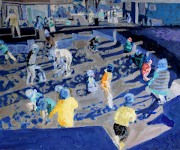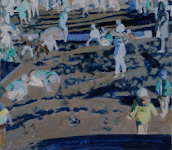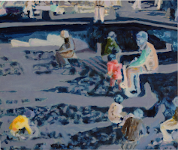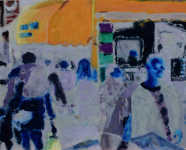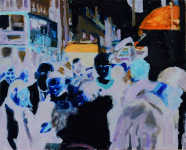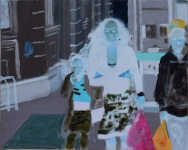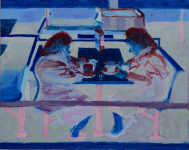|
In this series of paintings I have experimented with inverting colour. Red becomes green. Blue becomes orange. Yellow becomes purple. And the tones are also reversed. Dark becomes light and light becomes dark.
Digitally, it is now a simple process at the press of a button to invert the colour of an image on a screen or on a mobile phone. In analogue photography, such images are called negatives. However, it's the psychological impact of colour inversion that I am interested in: it's more complex and difficult to describe than the terms positive and negative, so I prefer to avoid using them.
Over many years, I have used photographs I take of everyday urban life around me as source material for making paintings. In the Inverse Colour paintings I used the same process, except that the starting point was photographs in which I had digitally inverted the colours.
Colour is the raw material of painting and perception of colour is generated in the processing of light by our bodies and brains. In inverting the colour I wanted to undo the process by which we easily slip into interpreting colour as image. I find it difficult to describe the effect of inverting the colour. Each viewer will experience it differently. Making the paintings undid my habits. I was influenced by the poet Rimbaud's phrase of a dereglement des sens - a disruption of the senses or of feeling.
There was also a political catalyst for the paintings. I made the first painting in inverted colours in a state of shock on the day after the UK referendum vote to leave the European Union in 2016. Brexit materially and emotionally affected my life and my family. I made a painting that brought together the personal and political impact in one image in which the colours were inverted. Inverting colour was a way of using an element that is intrinsic to painting as a means of opposition and critique. It changes the way we see. It expressed my disorientation and alienation from what was happening in my own country. During the Covid pandemic I made more pictures with inverted colours. Feeling isolated from my usual urban subject matter, I looked back at some of my previous work, and set about painting re-mixes in inverse colour. Inverting colour became a way I could visualise the psychological impact of the virus. The difficulty of imagining the picture in its true colours echoed the difficulty I felt in imagining life returning to how it was.
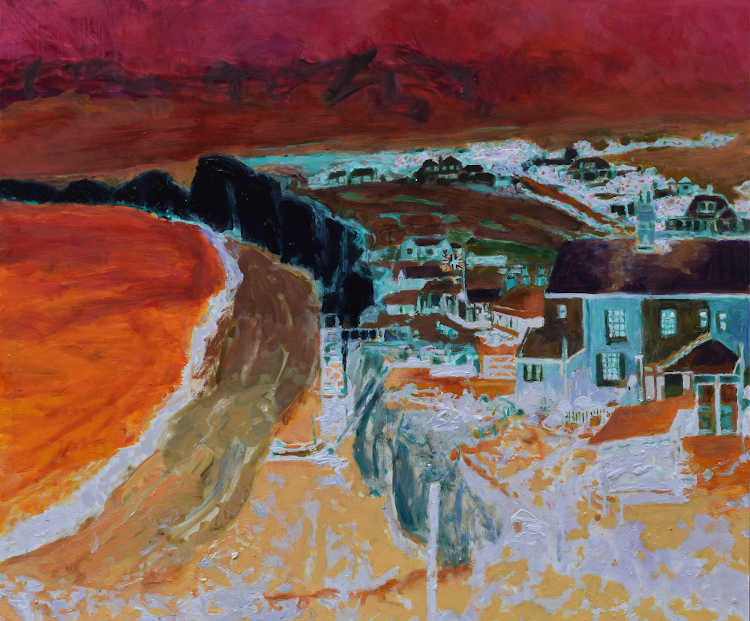
Birling Gap. 24 June 2016. Oil on board. 100 x 122cm.
This was the first painting I did in inverse colours. I made it the day immediately after the Brexit vote.
The painting is a view of Birling Gap and the Seven Sisters cliffs on the South coast of England. At its centre is a Union Jack flag, torn, also with its colours inverted.
The painting links elements of my family's history with critical moments of national crisis in a place that has a strong symbolic resonance with English identity - the Seven Sisters, those iconic white cliffs. My father lived here as a child with his mother and sister during the Battle of Britain and through the subsequent bombing, barred from going down to a beach cut off by defensive barbed wire. When the farm next door got a direct hit from a doodlebug, my granny evacuated with the children to the North. Members of the family are still in the area. The end terraced house in the painting used to belong to artist friends and an artist lived next door too. I used to go and stay until, one by one, the terraced houses have had to be demolished, as the crumbling cliffs of England are relentlessly eaten away by the sea.
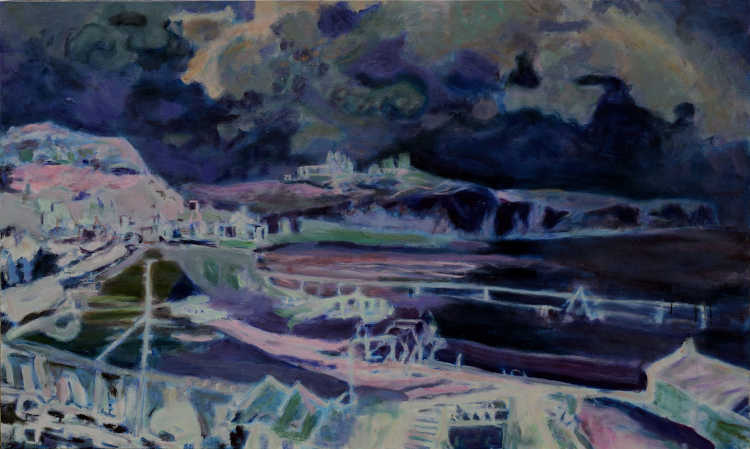
The Port at Dover (after Kokoschka). Oil on canvas. 76.5 x 128cm.
This picture inverts the colours of a painting of the port of Dover by Oskar Kokoschka. During the course of his extensive travels in Europe and North Africa in the 1920s, Kokoschka visited Britain and made a series of paintings here, including this one of Dover. In the 1930s with economic depression and the rise of facism, travel was less possible. Kokoschka settled in Prague, but fled in 1938 narrowly escaping the Nazi invasion. It was Britain that gave him refuge. Kokoschka consistently opposed fascism. During the war, he donated money from sales of his work to help starving and orphaned children on both sides of the conflict and he came to see himself as a defender of the values of European culture.
My inverse version of Kokoschka's painting was completed during the autumn 2019 as parliament battled to prevent a No Deal Brexit. The painting provided an image to express my fear and forebodings, by making visible the national reversal of the European values that Kokoschka held dear. Dover is not only symbolic for its white cliffs, it is also one of the places in the country where the effects of Brexit on movement of goods,services and people between the UK and Europe will be most clearly seen and obvious, and especially so if there is no deal, a danger that has not altogether gone away.
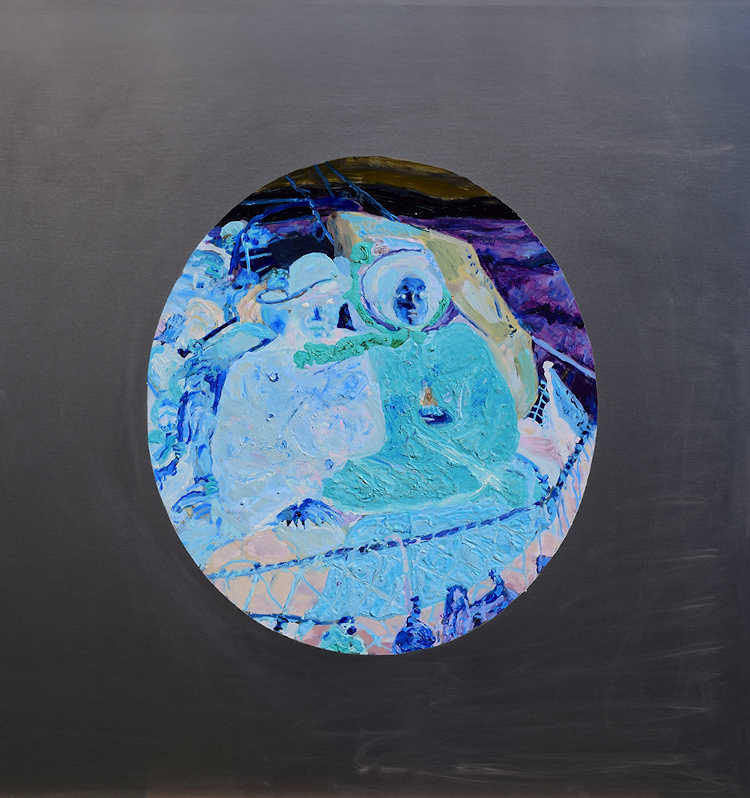
The Last of England (after Ford Madox Brown). Oil on aluminium. 76.5 x 73cm.
In making this picture I was reflecting upon attitudes to migrants. Ford Madox Brown made his iconic painting, The Last of England, to draw attention to conditions in England in the mid nineteenth century that were forcing people to leave the country to seek a "better life" in the colonies. In inverting the colours of his painting I had in mind the position of migrants coming the other way and the national shame of the reception they have received as a consequence of the government's deliberate adoption of a "hostile environment" policy and the fanning of anti-immigrant sentiment in the media. I invite English viewers to make the imaginative leap of seeing themselves as migrants rather than colonists. Perhaps then they would not so willingly throw away the precious right to freedom of movement in neighbouring countries.

Hounds of death (after Titian). Oil on canvas. 92 x 100cm.
I have long been fascinated by Titian's painting, "The Death of Actaeon", which is the first painting I head for every time I visit the National Gallery. Its story of Actaeon in the moment of being hunted down by his own hounds and killed by a goddess on account of a random encounter seemed even more relevant in the current circumstances of the Covid pandemic. Titian experienced plagues in Venice and eventually died of the plague. There's so much more I could say about Titian's painting, I learnt a lot in my attempt at re-painting it, not least that the original remains insuperable.
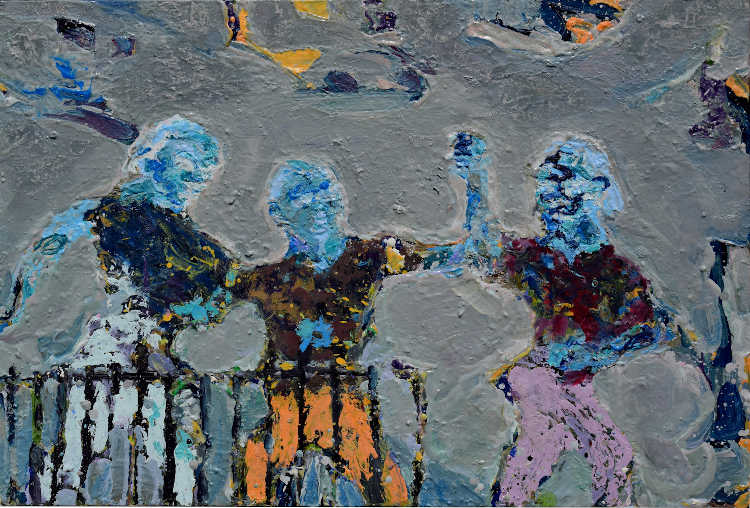
Three children. Oil on board. 62 x 93cm.
During the Covid lockdown I turned to my previous paintings to experiment with a series of "re-mixes", inverting the colour. In this painting I painted directly over an original painting I had done 20 years ago, at first directly substituting the inverted colour on top of the original, but as the painting proceeded I ended up re-working it freely on its own terms. This led to a further three new paintings of a children's playground in inverted colours.
|
|
|
|
|
|
|
Sandpit 1
Oil on canvas
75 x 90.5cm |
|
Sandpit 2
Oil on board
50 x 58cm |
|
Sandpit 3
Oil on board
46 x 55cm |
RE-MIXES: ELEGIES FOR STREET LIFE
During the Covid lockdown, I experimented with painting on aluminium. With the city closed down, I re-visited paintings I had made of London's street life. I was working from small, imperfect, inverted images of the photographs I had used for the original paintings (which can be located in the Street Scenes and Urban People galleries on this website) painting directly onto the unfamiliar shiny aluminum, and all these obstacles overwhelmed my endeavour to get through to the content of the painting - a shared urban streetlife which Covid had so suddenly erased.
|
|
|
|
|
|
|
Elegy for street life 2
Oil on aluminium
40 x 50cm
|
|
Elegy for street life 3
Oil on aluminium
40 x 50cm
|
|
Elegy for street life 4
Oil on aluminium
40 x 50cm
|
|
|
|
|
|
|
|
Elegy for street life 5
Oil on aluminium
40 x 50cm
|
|
Elegy for street life 6
Oil on aluminium
40 x 50cm
|
|
Elegy for street life 7
Oil on aluminium
40 x 50cm
|
|
|
|
|
|
|
|
Elegy for street life 8
Oil on aluminium
40 x 50cm
|
|
Elegy for street life 9
Oil on aluminium
40 x 50cm
|
|
Elegy for street life 10
Oil on aluminium
40 x 50cm
|
| |





